Physicochemical Composition Variability and Hydraulic Conditions in a Geothermal Borehole—The Latest Study in Podhale Basin, Poland
Abstract
:1. Introduction
2. Description of the Studied Area
3. Materials and Methods
3.1. Hydrodynamic Testing
- —reduced pressure value measured at the wellhead [Pa];
- Ps—dynamic pressure value measured at the wellhead [Pa];
- ρ(Tśr)—average density of the thermal water column in the well during its operation [kg/m3];
- L—borehole TVD [m];
- g—gravitational acceleration [m/s2].
- R—depression cone [m];
- s—depression [m];
- k—filtration coefficient [m/s].
3.2. Hydrogeochemical Testing
4. Results and Discussion
4.1. Hydrodynamic Testing
4.2. Hydrogeochemical Testing
- -
- determination of the wellhead pressure—the reading of the pressure value was made on the basis of the indications of a pressure gauge installed on the wellhead,
- -
- measurement of the water temperature at the outlet point by means of an automatic thermometer with a measurement accuracy of ±0.1 °C,
- -
- measurement of the conductivity (EC) of water at the outlet point using an automatic probe with a measurement accuracy of ±1 µS/cm at 20 °C.
5. Conclusions
Author Contributions
Funding
Acknowledgments
Conflicts of Interest
References
- Bielec, B.; Miecznik, M. Efekt termiczny w obliczeniach przewodności hydraulicznej w otworach ujmujących wodę termalną. Technika Poszukiwań Geologicznych Geotermi. Zrównoważony Rozw. 2012, 2, 45–54. [Google Scholar]
- Kawecki, M.W. Correction for temperature effect in the recovery of a pumped well. Ground Water 1995, 33, 917–926. [Google Scholar] [CrossRef]
- Kapuściński, J.; Nagy, S.; Dlugosz, P.; Biernat, H.; Bentkowski, A.; Zawisza, L.; Macuda, J.; Bujakowska, K. Zasady I Metodyka Dokumentowania Zasobów Wód Termalnych I Energii Geotermalnej Oraz Sposoby Odprowadzania Wód Zużytych; Poradnik Metodyczny: Warszawa, Poland, 1997. [Google Scholar]
- Ramey, H.J., Jr. Advanced in Practical Well Test Analysis. J. Pet. Technol. 1992, 44. Available online: https://www.onepetro.org/journal-paper/SPE-20592-PA (accessed on 24 July 2020). [CrossRef]
- Operacz, A.; Chowaniec, J. Perspective of geothermal water use in the Podhale Basin according to geothermal step distribution. Geol. Geophysics Environ. 2018, 44, 379–389. [Google Scholar] [CrossRef] [Green Version]
- Aliyu, M.D.; Chen, H.-P. Sensitivity analysis of deep geothermal reservoir: Effect of reservoir parameters on production temperature. Energy 2017, 129, 101–113. [Google Scholar] [CrossRef]
- Yildirim, N.; Parmanto, S.; Akkurt, G. Thermodynamic assessment of downhole heat exchangers for geothermal power generation. Renew. Energy 2019, 141, 1080–1091. [Google Scholar] [CrossRef]
- Kaczmarczyk, M.; Sowiżdżał, A.; Tomaszewska, B. Energetic and Environmental Aspects of Individual Heat Generation for Sustainable Development at a Local Scale—A Case Study from Poland. Energies 2020, 13, 454. [Google Scholar] [CrossRef] [Green Version]
- Górecki, W.; Sowiżdżał, A.; Hajto, M.; Wachowicz-Pyzik, A. Atlases of geothermal waters and energy resources in Poland. Environ. Earth Sci. 2015, 74, 7487–7495. [Google Scholar] [CrossRef] [Green Version]
- Sowiżdżał, A. Geothermal energy resources in Poland—Overview of the current state of knowledge. Renew. Sustain. Energy Rev. 2018, 82, 4020–4027. [Google Scholar] [CrossRef]
- Kaczmarczyk, M.; Tomaszewska, B.; Pająk, L. Geological and Thermodynamic Analysis of Low Enthalpy Geothermal Resources to Electricity Generation Using ORC and Kalina Cycle Technology. Energies 2020, 13, 1335. [Google Scholar] [CrossRef] [Green Version]
- Tomaszewska, B.; Szczepański, A. Possibilities for the efficient utilisation of spent geothermal waters. Environ. Sci. Pollut. Res. 2014, 21, 11409–11417. [Google Scholar] [CrossRef] [PubMed] [Green Version]
- Huculak, M.; Jarczewski, W.; Dej, M. Economic aspects of the use of deep geothermal heat in district heating in Poland. Renew. Sustain. Energy Rev. 2015, 49, 29–40. [Google Scholar] [CrossRef]
- Sokołowski, J.; Doktor, S.; Górecki, W.; Graniczny, M.; Myśko, A.; Jawor, E.; Karnkowski, P.; Ney, R.; Nowotarski Cz Poprawa, D.; Słuszkiewicz, T.; et al. Projekt Badań Geologicznych Określających Zasoby I Warunki Eksploatacji Surowców Energetycznych W Niecce Podhalańskiej; Arch. OK PIG-PIB: Kraków, Poland, 1978; unpublished. [Google Scholar]
- ISO. ISO/IEC 17025—General Requirements for the Competence of Testing and Calibration Laboratories; ISO: Geneva, Switzerland, 2017. [Google Scholar]
- Chowaniec, J.; Olszewska, B.; Poprawa, D.; Skulich, J.; Smagowicz, M. Dokumentacja Hydrogeologiczna Zasobów Wód Podziemnych—Wody Termalne. Otwór Chochołów PIG-1; Centralne Archiwum Geologiczne w Warszawie: Warszawa, Poland, 1992. [Google Scholar]
- Bujakowski, W.; Barbacki, A. Potential for geothermal development in Southern Poland. Geothermics 2004, 33, 383–395. [Google Scholar] [CrossRef]
- Bujakowski, W.; Tomaszewska, B.; Miecznik, M. The Podhale geothermal reservoir simulation for long-term sustainable production. Renew. Energy 2016, 99, 420–430. [Google Scholar] [CrossRef]
- Barbacki, A.P.; Bujakowski, W.; Pająk, L. Atlas Zbiorników Wód Geotermalnych Małopolski; Publishing House of the Mineral and Energy Economy Research Institute of the Polish Academy of Sciences: Kraków, Poland, 2006. [Google Scholar]
- Kępińska, B. Warunki Termiczne I Hydrotermalne Podhalańskiego Systemu Geotermalnego; Studia, Rozprawy, Monografie, Zeszyt 135; Publishing House of the Mineral and Energy Economy Research Institute of the Polish Academy of Sciences: Kraków, Poland, 2006. [Google Scholar]
- Kępińska, B. The role of the Podhale geothermal system’s research for geothermal water. Technika Poszukiwań Geologicznych Geotermia Zrównoważony Rozwój 2009, 244, 29–48. [Google Scholar]
- Kępińska, B.; Ciągło, J. Możliwości zagospodarowania wód geotermalnych Podhala do celów balneoterapeutycznych i rekreacyjnych. Geologia 2008, 34, 541–559. [Google Scholar]
- Kępińska, B. Geothermal energy country update report from Poland, 2010–2014. In Proceedings of the World Geothermal Congress 2015, Melbourne, Australia, 19–24 April 2015. [Google Scholar]
- Kaczmarczyk, M.; Tomaszewska, B.; Operacz, A. Sustainable utilization of low enthalpy geothermal resources to electricity generation through a cascade system. Energies 2020, 13, 2495. [Google Scholar] [CrossRef]
- Bugajski, P.; Nowobilska-Majewska, E.; Nowobilska-Luberda, A.; Bergel, T. The use of geothermal waters in Podhale in terms of tourism and industrial applications. J. Ecol. Eng. 2017, 18, 185–191. [Google Scholar] [CrossRef]
- Chowaniec, J.; Zuber, A.; Ciężkowski, W. Prowincja karpacka. In Hydrogeologia Regionalna Polski, T. II. Wody Mineralne, Lecznicze I Termalne Oraz Kopalniane; Paczyński, B., Sadurski, A., Eds.; Państwowy Instytut Geologiczny: Warszawa, Poland, 2007. [Google Scholar]
- Oszczypko, N. Charakterystyka tektoniczna i geologiczna polskich Karpat Zachodnich. In Atlas Zasobów Geotermalnych Polskich Karpat Zachodnich; Górecki, W., Ed.; Goldruk: Kraków, Poland, 2011. [Google Scholar]
- Cieszkowski, M.; Uchman, A.; Chowaniec, J. Litostratygrafia sukcesji osadowej niecki podhalańskiej. In Budowa Geologiczna Tatr I Podhala Ze Szczególnym Uwzględnieniem Zjawisk Geotermalnych Na Podhalu; Uchman, A., Chowaniec, J., Eds.; Państwowy Instytut Geologiczny: Bukowina Tatrzańska, Poland, 2009. [Google Scholar]
- Chowaniec, J. Podhale Basin—The Most Perspective Reservoirof Thermal Waters in the Polish Carpathian. Współczesne Problemy Hydrogeologii 2007, 13, 931–938. [Google Scholar]
- Chowaniec, J.; Duliński, M.; Mochalski, P.; Najman, J.; Śliwka, I.; Zuber, A. Environmental tracers in thermal waters of Podhale Basin. Przegląd Geologiczny 2009, 57, 685–693. [Google Scholar]
- Józefko, I.; Bielec, B. Dokumentacja Hydrogeologiczna Ustalająca Zasoby Eksploatacyjne Ujęcia Wód Termalnych “Chochołów PIG-1”; Centralne Archiwum Geologiczne w Warszawie: Warszawa, Poland, 2009; unpublished. [Google Scholar]
- Bielec, B.; Operacz, A. Dodatek Do Dokumentacji Hydrogeologicznej Ustalającej Zasoby Eksploatacyjne Ujęcia Wód Termalnych “Chochołów PIG-1”; VENA: Kraków, Poland, 2018; unpublished. [Google Scholar]
- Theis, C.V. The relation between the lowering of the piezometric surface and the rate and duration of discharge of a well using groundwater storage. Trans. Amer. Geophys. Union 1935, 16, 519–524. [Google Scholar] [CrossRef]
- Agarwal, R.G. A new method to account for producing time effects when drawdown type curves are used to analyze pressure buildup and other test data. In Proceedings of the 55th Annual Fall Technical Conference and Exhibition of the Society of Petroleum Engineers, Paper SPE 9289, Dallas, TX, USA, 21–24 September 1980. [Google Scholar]
- Dąbrowski, S.; Przybyłek, J. Metodyka Próbnych Pompowań W Dokumentowaniu Zasobów Wód Podziemnych. Poradnik Metodyczny; Bogucki Wydawnictwo Naukowe: Poznań, Poland, 2005. [Google Scholar]
- Bielec, B.; Hołojuch, G. Pompowanie testowe w dokumentowaniu wód termalnych. Technika Poszukiwań Geologicznych Geotermia Zrównoważony Rozwój 2011, 1–2, 319–328. [Google Scholar]
- Chowaniec, J.; Długosz, P.; Drozdowski, B.; Nagy, S.; Poprawa, D.; Witczak, S.; Witek, K. Dokumentacja Hydrogeologiczna Zasobów Wód Termalnych Niecki Podhalańskiej; Centralne Archiwum Geologiczne w Warszawie: Warszawa, Poland, 1997; unpublished. [Google Scholar]
- ISO. ISO/IEC 5667-11: Water Quality—Sampling—Part 11: Guidance on Sampling of Groundwaters; ISO: Geneva, Switzerland, 2004. [Google Scholar]
- Witczak, S.; Kania, J.; Kmiecik, E. Guidebook on Selected Physical and Chemical Indicators of Groundwater Contamination and Methods of Their Determination; Biblioteka Monitoringu Środowiska: Warszawa, Poland, 2013. [Google Scholar]
- Zdechlik, R.; Dwornik, M.; Wątor, K. Practical aspects of water sampling in groundwater monitoring. Biuletyn Państwowego Instytutu Geologicznego 2013, 456, 659–664. [Google Scholar]
- Guilford, J.P. Fundamental Statistics in Psychology and Education; McGraw-Hill: New York, NY, USA, 1965. [Google Scholar]
- Lee, J. Well Testing; SPE Textbook Series; SPE: Dallas, TX, USA, 1982; Volume 1. [Google Scholar]
- Operacz, A. Variability of basic geothermal water parameters in Chochołów PIG-1 borehole in the western part of the Podhale Basin. Infrastruct. Ecol. Rural Areas 2018, 4, 961–972. [Google Scholar]
- Jeleński, T.; Dendys, M.; Tomaszewska, B.; Pająk, L. The potential of RES in the reduction of air pollution: The SWOT analysis of smart energy management solutions for Krakow Functional Area (KrOF). Energies 2020, 13, 1754. [Google Scholar] [CrossRef] [Green Version]
- Pająk, L.; Tomaszewska, B.; Bujakowski, W.; Bielec, B.; Dendys, M. Review of the Low-Enthalpy Lower Cretaceous Geothermal Energy Resources in Poland as an Environmentally Friendly Source of Heat for Urban District Heating Systems. Energies 2020, 13, 1302. [Google Scholar] [CrossRef] [Green Version]
- Şimşek, S.; Yıldırım, N.; Gülgör, A. Developmental and environmental effects of the Kızıldere geothermal power project, Turkey. Geothermics 2005, 34, 239–256. [Google Scholar] [CrossRef]
- Kaczmarczyk, M. Impact of rock mass temperature on potential power and electricity generation in the ORC installation. E3S Web Conf. 2017, 24, 02007. [Google Scholar] [CrossRef] [Green Version]
- Fiaschi, D.; Manfrida, G.; Rogai, E.; Talluri, L. Exergoeconomic analysis and comparison between ORC and Kalina cycles to exploit low and medium-high temperature heat from two different geothermal sites. Energy Convers. Manag. 2017, 154, 503–516. [Google Scholar] [CrossRef]
- Bertani, R. Geothermal Power Generation in the World 2010–2014 Update Report. In Proceedings of the World Geothermal Congress 2015, Melbourne, Australia, 19–25 April 2015. [Google Scholar]
- Kaczmarczyk, M. Potential of existing and newly designed geothermal heating plants in limiting of low emissions in Poland. E3S Web Conf. 2018, 44, 62. [Google Scholar] [CrossRef] [Green Version]
- Benedek, J.; Tihamér-Tibor, S.; Bartók, B. Evaluation of renewable energy sources in peripheral areas and renewable energy-based rural development. Renew. Sustain. Energy Rev. 2018, 90, 516–535. [Google Scholar] [CrossRef]
- Frank, A.G.; Gerstlberger, W.; Paslauski, C.A.; Visintainer-Lerman, L.; Ayala, N.F. The contribution of innovation policy criteria to the development of local renewable energy systems. Energy Policy 2018, 115, 353–365. [Google Scholar] [CrossRef]
- Kaczmarczyk, M. Methodology and impact categories of environmental life cycle assessment in geothermal energy sector. E3S Web Conf. 2019, 100, 32. [Google Scholar] [CrossRef]

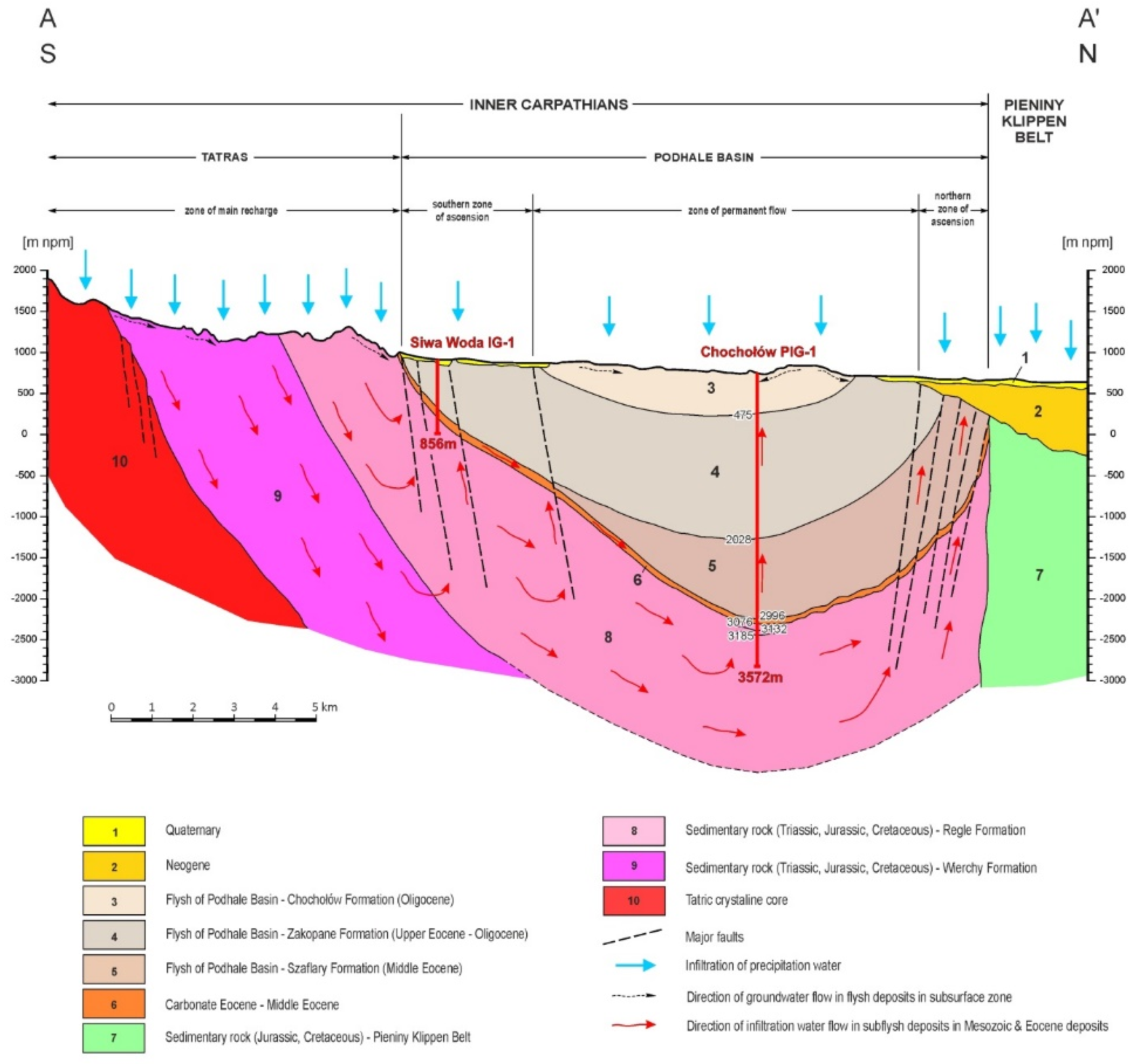
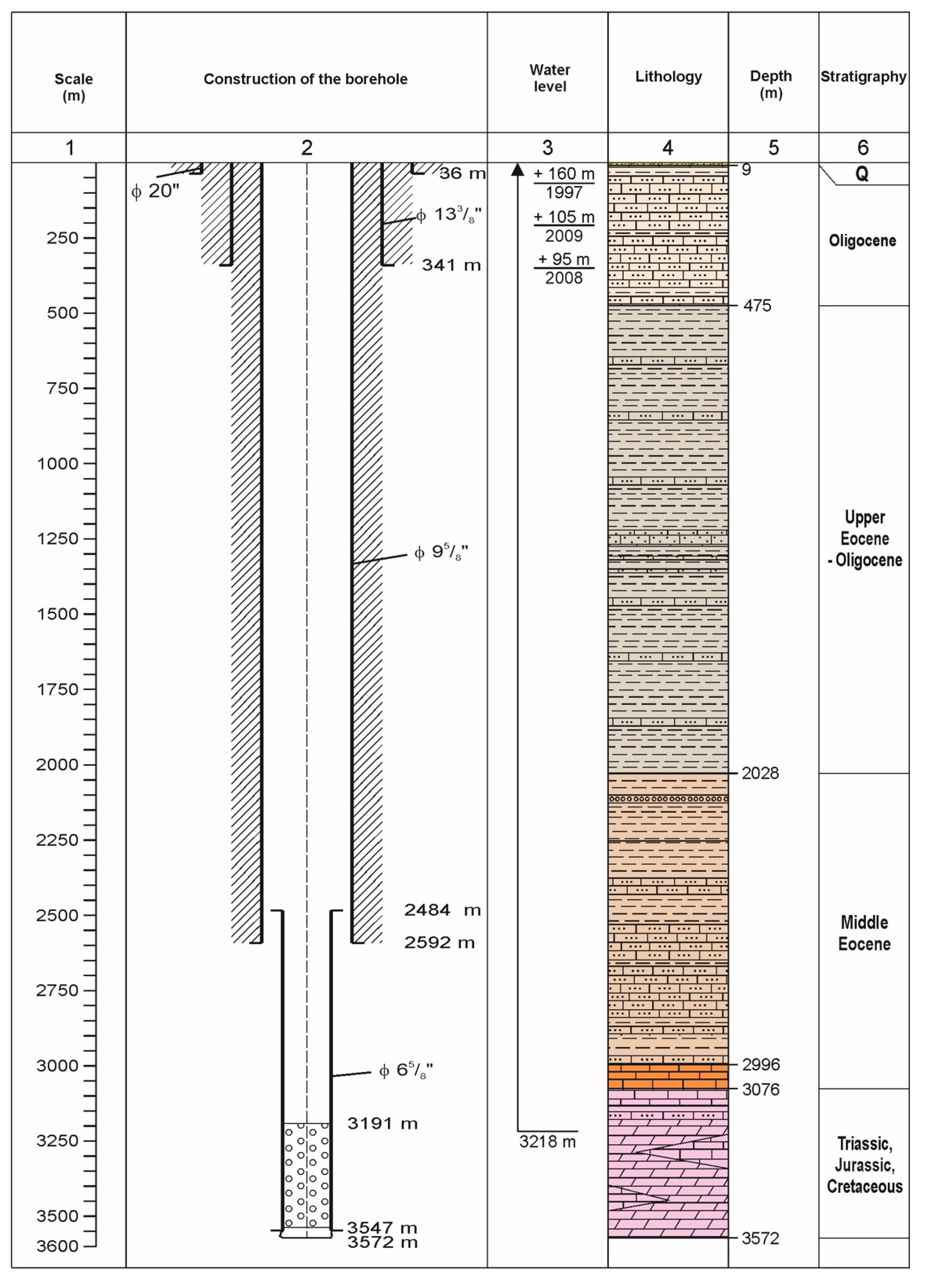
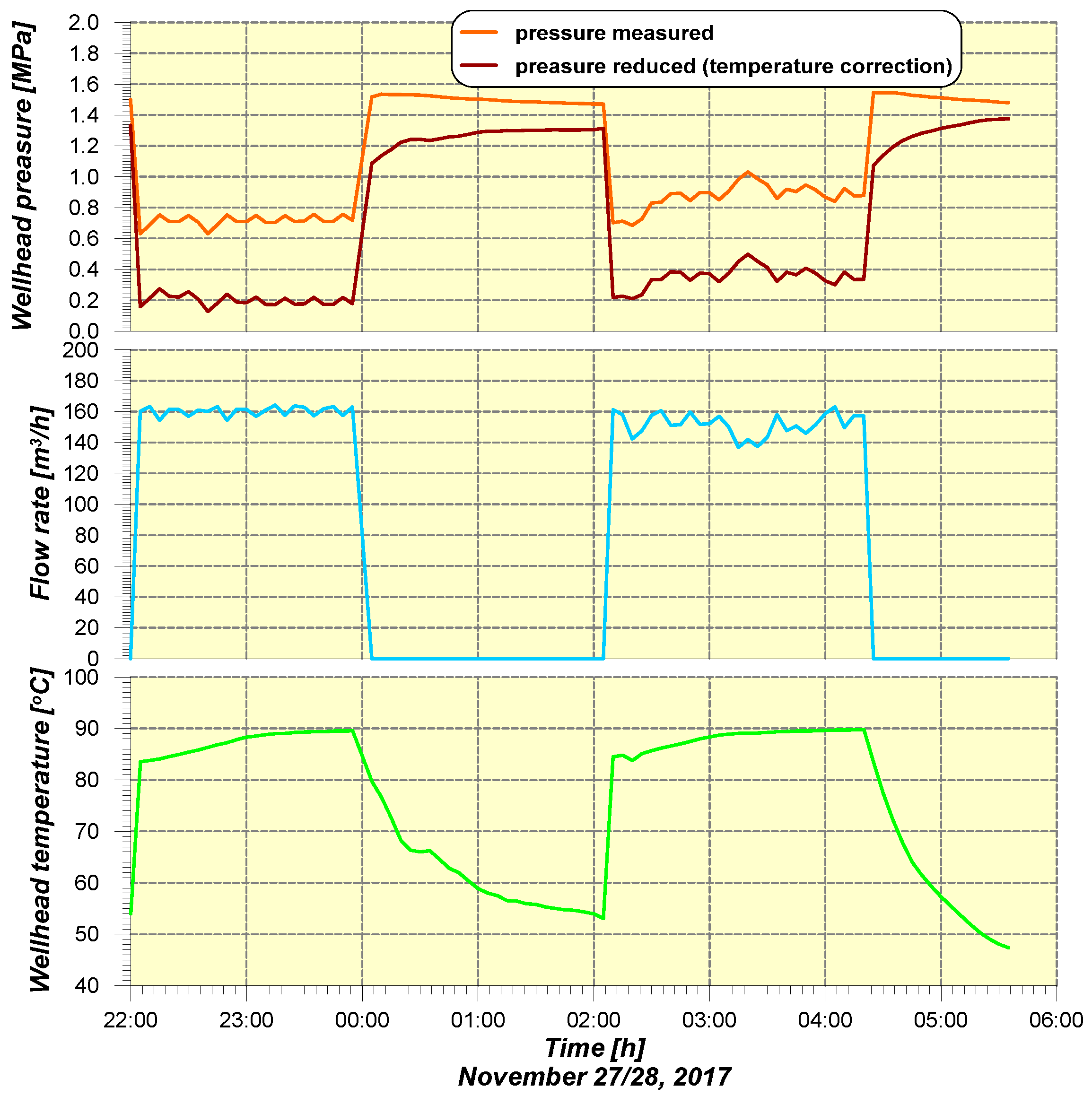

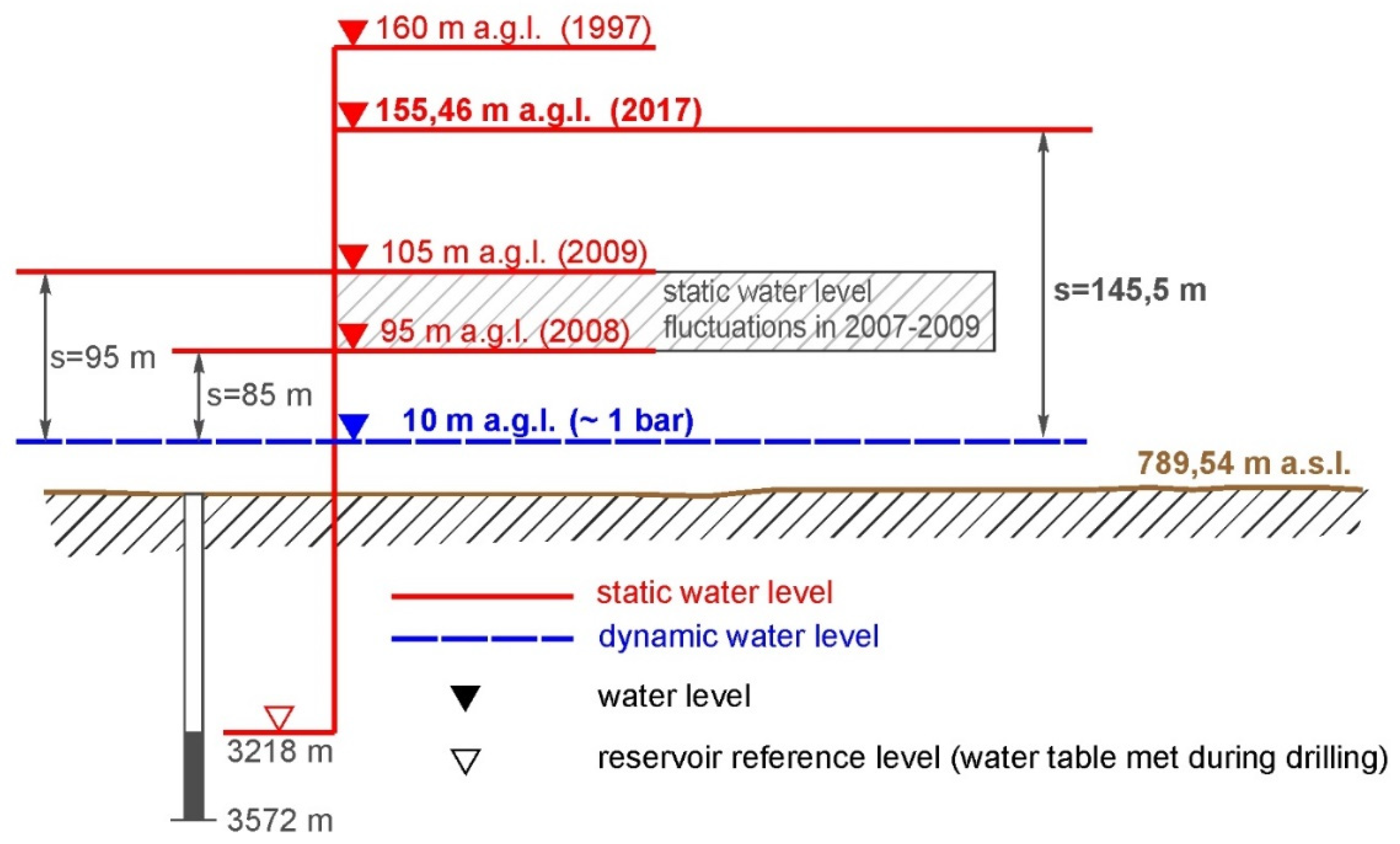

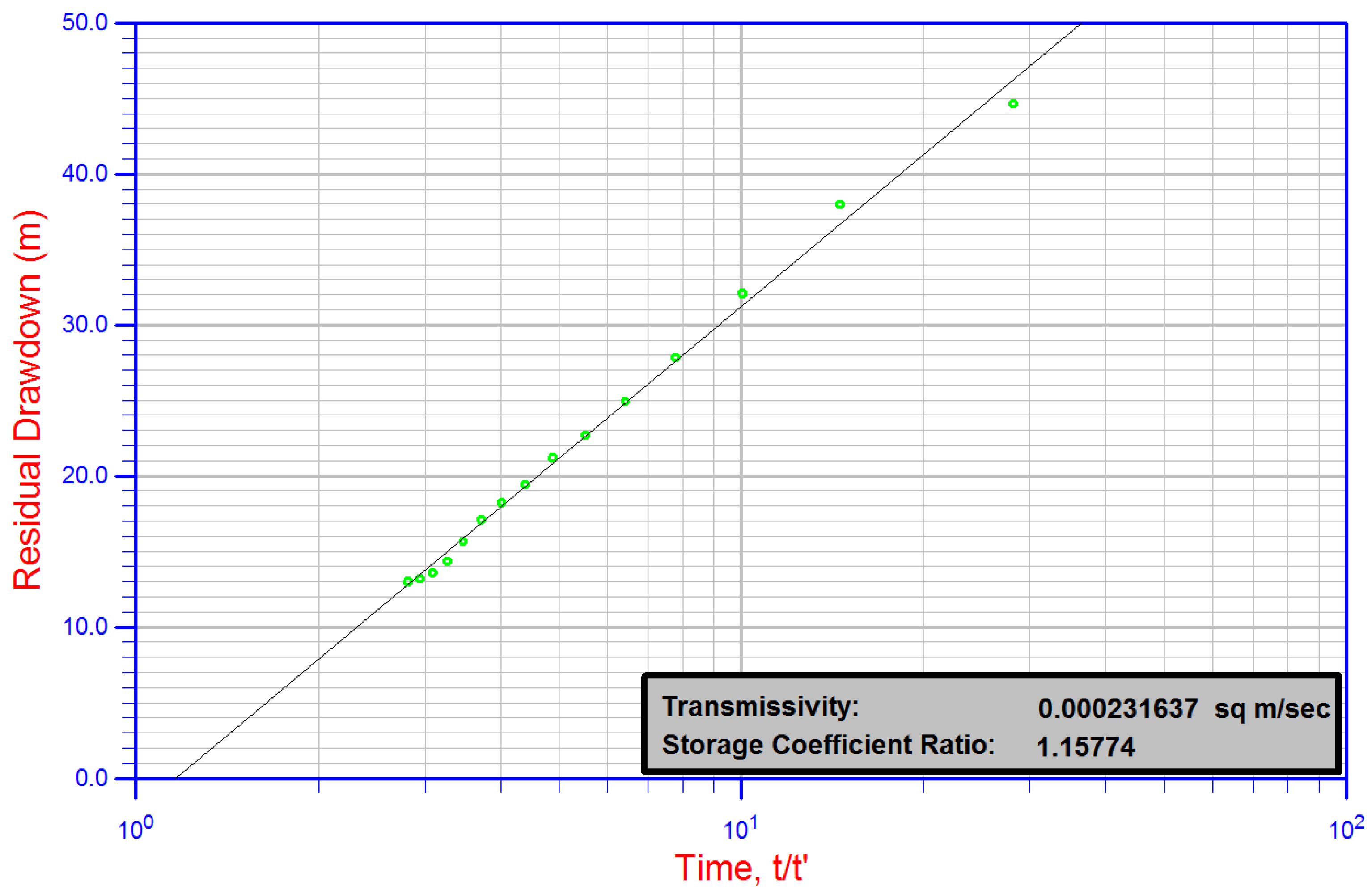
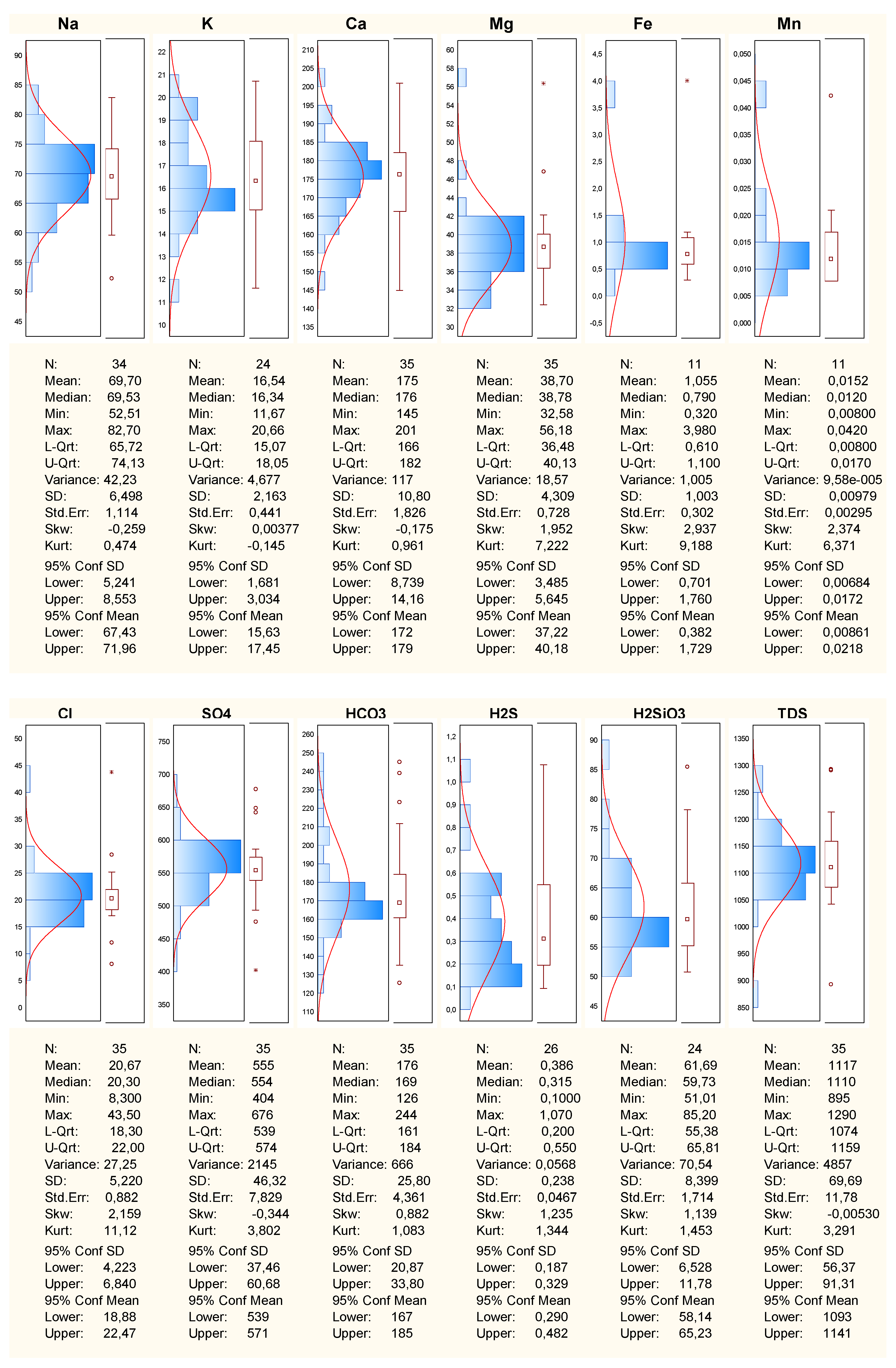
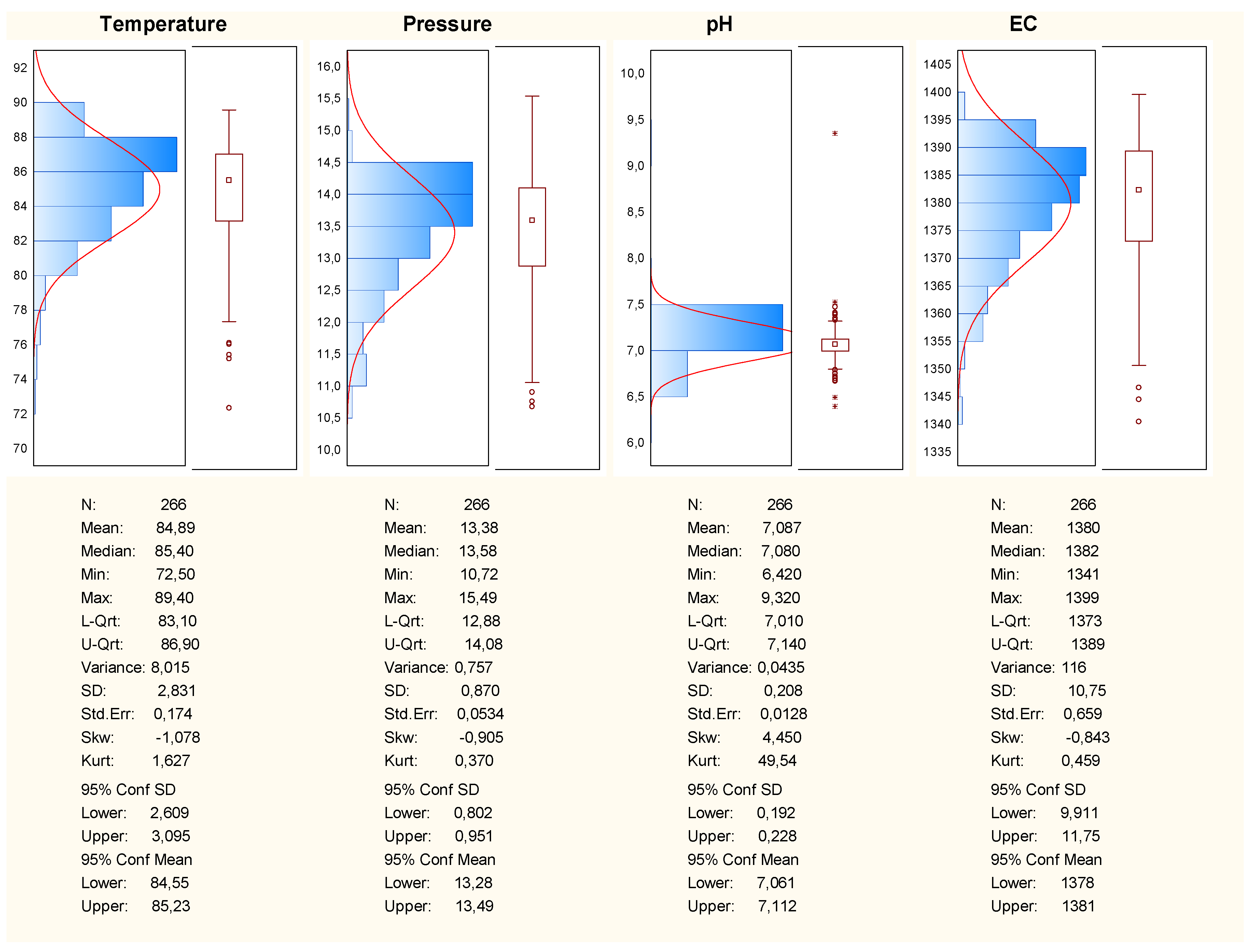

| Scope of Work | Details of Work | |
|---|---|---|
| preparation work | shutdown of borehole exploitation for 2 h | |
| single-stage, repeatable hydrodynamic test | Phase I: | |
| ● pumping (2 h) | ||
| - wellhead pressure before pumping: | 1.5 MPa | |
| - average efficiency during pumping: | 160.4 m3/h | |
| - wellhead pressure at the end of pumping: | 0.72 MPa | |
| - thermal water temperature at the end of pumping: | 89.6 °C | |
| ● stabilisation (2 h, 5 min) | ||
| Phase II: | ||
| ● pumping (2 h, 15 min): | ||
| - wellhead pressure before pumping | 1.47 MPa | |
| - average efficiency during pumping: | 151.9 m3/h | |
| - wellhead pressure at the end of pumping: | 0.88 MPa | |
| - thermal water temperature at the end of pumping | 89.8 °C | |
| ● stabilisation (1 h, 15 min) | ||
| Dynamic Level | Flow Rate [m3/h] | Depression/Pressure [m]/[MPa] | Unit Flow Rate [m3/h/1 mS] | Water Temperature at Wellhead [°C] | Time [hh:mm] |
|---|---|---|---|---|---|
| Phase I | 160.4 | 79.5/0.78 | 2.02 | 89.6 | 02:00 |
| Stabilisation | – | – | – | – | 02:05 |
| Phase II | 151.9 | 63.2/0.62 | 2.40 | 89.8 | 02:15 |
| Stabilisation | – | – | – | – | 01:15 |
| Analysis Type | Dynamic Level | Conductivity [m2/s] | Filtration Coefficient “k” [m/s] |
|---|---|---|---|
| Lift analysis (with temperature correction) | Phase I | 3.82 × 10−4 | 1.16 × 10−6 |
| Phase II | 2.32 × 10−4 | 7.04 × 10−7 |
| Parameter | Units | Average | Interval | Number of Analysed Samples |
|---|---|---|---|---|
| Temperature | °C | 84.9 | 72.5–89.4 | 267 |
| Wellhead pressure | Bar | 13.38 | 10.72–15.49 | 267 |
| EC (electrical conductivity) | µS/cm at 20 °C | 1380 | 1341–1399 | 267 |
| pH | – | 7.09 | 6.42–9.32 | 267 |
| Total dissolved solids (TDS) | mg·dm−3 | 1116.8 | 895.2–1290.3 | 36 |
| Calcium (Ca) | mg·dm−3 | 175.28 | 145.3–200.6 | 36 |
| Magnesium (Mg) | mg·dm−3 | 38.70 | 32.58–56.18 | 36 |
| Sodium (Na) | mg·dm−3 | 69.7 | 52.51–82.7 | 36 |
| Chlorides (Cl) | mg·dm−3 | 20.67 | 8.3–43.5 | 36 |
| Bicarbonates (HCO3) | mg·dm−3 | 176.3 | 126.3–244.4 | 36 |
| Potassium (K) | mg·dm−3 | 16.54 | 11.67–20.66 | 25 |
| Iron (Fe) | mg·dm−3 | 1.06 | 0.32–3.98 | 12 |
| Manganese (Mn) | mg·dm−3 | 0.015 | 0.008–0.042 | 12 |
| Sulphur (SO4) | mg·dm−3 | 555.3 | 403.5–676.1 | 36 |
| Hydrogen sulfide (H2S) | mg·dm−3 | 0.39 | 0.1–1.07 | 36 |
| Metasilic acid (H2SiO3) | mg·dm−3 | 61.69 | 51.01–85.2 | 25 |
© 2020 by the authors. Licensee MDPI, Basel, Switzerland. This article is an open access article distributed under the terms and conditions of the Creative Commons Attribution (CC BY) license (http://creativecommons.org/licenses/by/4.0/).
Share and Cite
Operacz, A.; Bielec, B.; Tomaszewska, B.; Kaczmarczyk, M. Physicochemical Composition Variability and Hydraulic Conditions in a Geothermal Borehole—The Latest Study in Podhale Basin, Poland. Energies 2020, 13, 3882. https://doi.org/10.3390/en13153882
Operacz A, Bielec B, Tomaszewska B, Kaczmarczyk M. Physicochemical Composition Variability and Hydraulic Conditions in a Geothermal Borehole—The Latest Study in Podhale Basin, Poland. Energies. 2020; 13(15):3882. https://doi.org/10.3390/en13153882
Chicago/Turabian StyleOperacz, Agnieszka, Bogusław Bielec, Barbara Tomaszewska, and Michał Kaczmarczyk. 2020. "Physicochemical Composition Variability and Hydraulic Conditions in a Geothermal Borehole—The Latest Study in Podhale Basin, Poland" Energies 13, no. 15: 3882. https://doi.org/10.3390/en13153882
APA StyleOperacz, A., Bielec, B., Tomaszewska, B., & Kaczmarczyk, M. (2020). Physicochemical Composition Variability and Hydraulic Conditions in a Geothermal Borehole—The Latest Study in Podhale Basin, Poland. Energies, 13(15), 3882. https://doi.org/10.3390/en13153882







